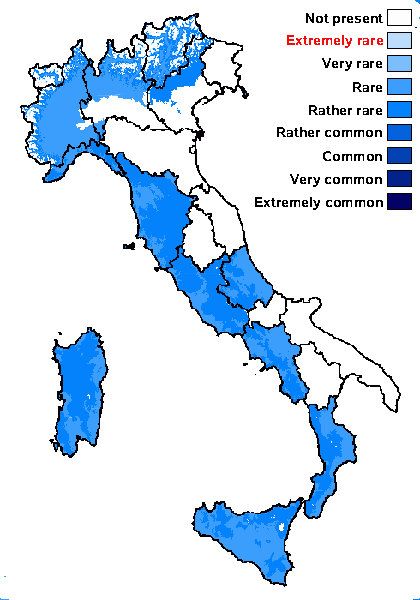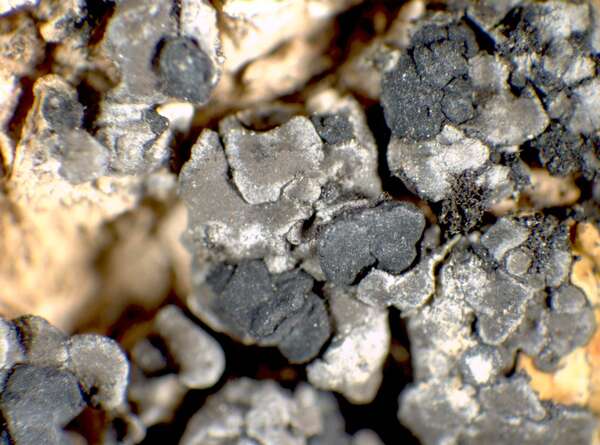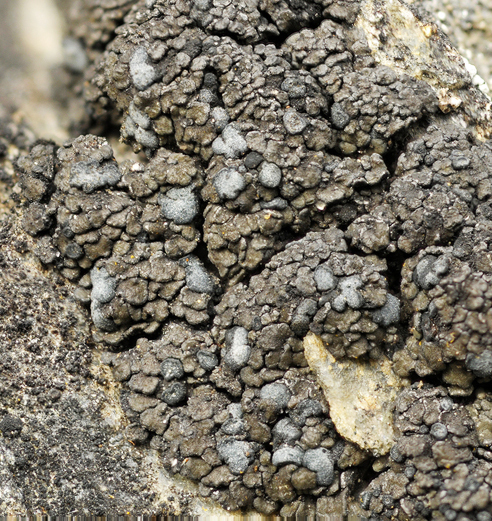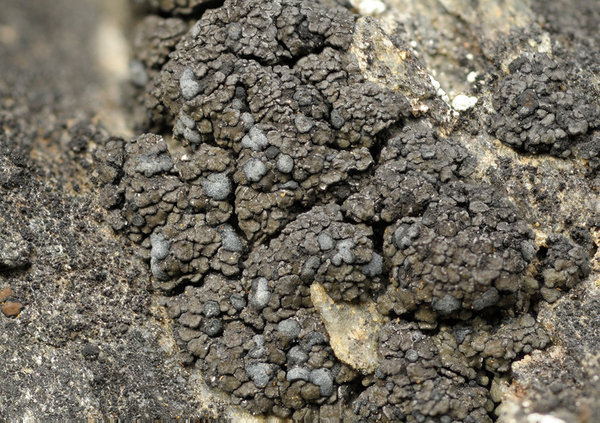Toninia cinereovirens (Schaer.) A. Massal.
Ric. Auton. Lich. Crost.: 107, 1852. Basionym: Lecidea cinereovirens Schaer. - Lich. Helv. Spicil., 3: 109, 1828.
Synonyms: Bilimbia cinereovirens (Schaer.) Jatta; Bilimbia fallasca (A. Massal.) Jatta; Bilimbia nigrescens (Anzi) Jatta; Toninia fallasca A. Massal.; Toninia nigrescens Anzi; Toninia olivaceoatra H. Magn.; Toninia potieri Maheu & Werner; Toninia sbarbaronis B. de Lesd.
Distribution: N - VG, Ven (Lazzarin 2000b), TAA, Lomb, Piem (Isocrono & al. 2004, Morisi 2005), VA (Piervittori & Isocrono 1999), Lig (Valcuvia & al. 2000). C - Tosc, Laz (Genovesi & al. 2011, 2011b), Abr (Caporale & al. 2016), Sar (Rizzi & al. 2011). S - Camp (Garofalo & al. 1999, Ricciardi & al. 2000), Cal (Puntillo 1996), Si (Caniglia & Grillo 2001, Grillo & Caniglia 2004).
Description: Thallus squamulose, forming irregular, up to 4 cm wide patches, the squamules brown to dark brown, sometimes with a dark grey margin, epruinose, dull to somewhat shiny, up to 3 mm wide, weakly concave to convex, contiguous to slightly imbricate, often deeply lobed, the cortex sometimes with shallow fissures; lower surface brown. Upper cortex 60-100 μm thick, including an up to 40 μm thick epinecral layer lacking crystals; medulla white, lacking crystals; lower cortex poorly developed. Apothecia frequent, lecideine, sessile, flat to convex, 0.7-1 mm across, black, but sometimes faintly pruinose on disc. Proper exciple colourless in inner part, dark brown in outer part, K-, N-; epithecium olivaceous brown to blue-green, K-, N+ violet; hymenium colourless, 60-70 μm high; paraphyses simple or sparingly branched and anastomosing, not conglutinated, the apical cell distinctly swollen and covered by a gelatinous pigment cap; hypothecium pale brown to colourless. Asci 8-spored, clavate, surrounded by a gelatinous I+ blue coat, with a well-developed I+ blue tholus, a I+ darker blue tube and a well-developed ocular chamber, Bacidia-type. Ascospores 1-3-septate, hyaline, ellipsoid to bacilliform, 13-32 x 3-4.5 μm. Pycnidia partly projecting with a black ostiole. Conidia filiform. Photobiont chlorococcoid. Spot tests: thallus K-, C-, KC-, P-, UV-. Chemistry: thallus without lichen substances.Note: a mainly southern, perhaps incompletely holarctic species found on steeply inclined, somehow weathered faces of calciferous and basic siliceous rocks with some seepage of water after rain, often in rock fissures and on colonies of cyanobacteria.
Growth form: Squamulose
Substrata: rocks
Photobiont: green algae other than Trentepohlia
Reproductive strategy: mainly sexual
Subcontinental: restricted to areas with a dry-subcontinental climate (e.g. dry Alpine valleys, parts of Mediterranean Italy)
On otherwise dry surfaces with short periods of water seepage after rain
Commonnes-rarity: (info)
Alpine belt: absent
Subalpine belt: extremely rare
Oromediterranean belt: absent
Montane belt: rather rare
Submediterranean belt: rare
Padanian area: absent
Humid submediterranean belt: rather rare
Humid mediterranean belt: rare
Dry mediterranean belt: rare

Predictive model
Herbarium samples


P.L. Nimis; Owner: Department of Life Sciences, University of Trieste
Herbarium: TSB (13195)
2001/12/01

Collezione lichenologica Abramo Massalongo del Museo di Storia Naturale G. Ligabue di Venezia - Autori: Seggi, Linda; Trabucco, Raffaella Proprietà: Fondazione Musei Civici di Venezia - CC BY-NC
Italy, Veneto, in opp. Auronzo 1855

Collezione lichenologica Abramo Massalongo del Museo di Storia Naturale G. Ligabue di Venezia - Autori: Seggi, Linda; Trabucco, Raffaella Proprietà: Fondazione Musei Civici di Venezia - CC BY-NC
Italy, Veneto, in oppido Grezzana (Fallasco) 1855
as Toninia fallasca
Growth form: Squamulose
Substrata: rocks
Photobiont: green algae other than Trentepohlia
Reproductive strategy: mainly sexual
Subcontinental: restricted to areas with a dry-subcontinental climate (e.g. dry Alpine valleys, parts of Mediterranean Italy)
On otherwise dry surfaces with short periods of water seepage after rain
Commonnes-rarity: (info)
Alpine belt: absent
Subalpine belt: extremely rare
Oromediterranean belt: absent
Montane belt: rather rare
Submediterranean belt: rare
Padanian area: absent
Humid submediterranean belt: rather rare
Humid mediterranean belt: rare
Dry mediterranean belt: rare

Predictive model
| Herbarium samples |


P.L. Nimis; Owner: Department of Life Sciences, University of Trieste
Herbarium: TSB (13195)
2001/12/01

Collezione lichenologica Abramo Massalongo del Museo di Storia Naturale G. Ligabue di Venezia - Autori: Seggi, Linda; Trabucco, Raffaella Proprietà: Fondazione Musei Civici di Venezia - CC BY-NC
Italy, Veneto, in opp. Auronzo 1855

 INDEX FUNGORUM
INDEX FUNGORUM
 GBIF
GBIF
 DOLICHENS
DOLICHENS





